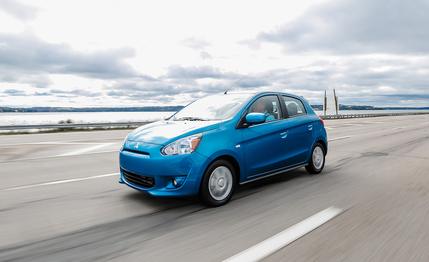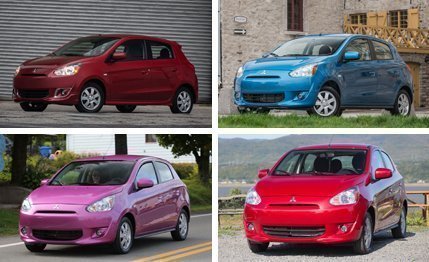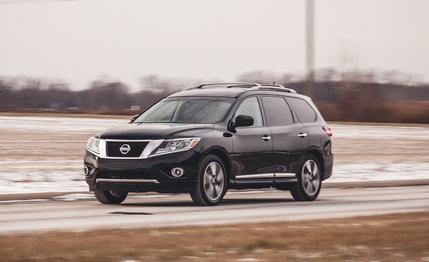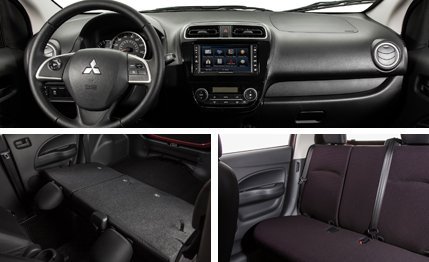 Instrumented Test
Instrumented Test
Way back in 1989, Mitsubishi scored a 10Best win with its Mirage Turbo. That delightful little compact led its class in refinement, performance, and design. Fast-forward 25 years to the 2014 Mitsubishi Mirage and it looks like things have gone backward—fast.
If the new Mirage were sent back a quarter century, it probably couldn’t return with a 10Best trophy unless it wrestled one away from the old Mirage and raced back into the time machine. But with 74 horsepower, the new Mirage isn’t racing anywhere. Floor it, something you’ll find yourself doing a lot, and the 77 decibels of ringing three-cylinder grittiness will make you wonder if there’s actually a leaf blower under the hood.
 This new Mirage looks as if it's about to burst into tears. Its lackluster value proposition put us in a similar emotional state..
This new Mirage looks as if it's about to burst into tears. Its lackluster value proposition put us in a similar emotional state..
Even when idling, the little 1.2-liter sends quivers through the entire car. And should you opt for the CVT, the trio of cylinders will grumble in protest every time you try to accelerate. And by acceleration, we’re talking about a zero-to-60 time of 10.9 seconds and a quarter-mile time of 18.3 seconds at 75 mph. This is from the Evo company?
Small-car shoppers likely will be more interested in the Mirage’s 37-mpg city/44-mpg highway fuel efficiency. We couldn’t verify those numbers, though; we managed an unimpressive 26 mpg, mostly because we found ourselves using every bit of the 1.2’s power just to keep from being run over by pelotons of shouting cyclists.
Using 100 percent of a car’s capabilities can be entertaining, even if the car itself isn’t very capable. And the Mirage is one of those rare cars that makes speed limits seem reasonable. Velocity takes patience, passes take serious planning, and you’ll want to maintain every possible mile per hour through corners by exploiting the 0.74 g of grip from the slight 165/65R-14 Dunlops.

We do like the tossable, non-threatening nature of the Mirage when you hustle it. It only weighs 2066 pounds, or 15 more than a Lotus Elise SC. But that’s hardly enough to make up for the weak and noisy engine. There’s so little fat on the Mirage that you’ll feel close to the vibrations and sounds of machinery. That lack of refinement gets old, though. And light weight and a 59.1-inch height mean that on the highway, you’re the leaf, not the blower.
We realize that this vehicle is intended as basic transportation, but that’s no excuse for looking like a Chinese copy of an old Toyota Yaris. It doesn’t cost a carmaker any more money to build an attractive or modern-looking car, so why does the Mirage look as if it’s two decades old?
Things improve inside. A touch of piano black on the center console dresses up the pleasant but generic interior. You’ll soon notice, however, that there’s no center armrest and that every last piece of plastic is hard. The front seats are spacious, but the absence of a telescoping steering wheel makes for a compromised driving position. Rear-seat space is tight, even if large doors make getting in and out easy.
 High feature content can't disguise its lack of refinement. There's too much small-car goodness out there for the Mirage to matter..
High feature content can't disguise its lack of refinement. There's too much small-car goodness out there for the Mirage to matter..
Base manual versions start at $13,790, and our ES trim–level Mirage came loaded with navigation and automatic climate control for $16,890. That’s a first-world price for a car that behaves like something you’d rent on vacation in Guatemala. For that money you can buy a Hyundai Accent, a Kia Rio, a Mazda 2, a Toyota Yaris, or even a Nissan Versa.
Granted, those cars won’t have navigation and automatic climate control for $17,000, but they are all more refined, powerful, and satisfying to live with than the Mirage. And while the Mirage is amusing in a they-sure-don’t-make-them-like-this-anymore way, so is a Commodore 64. Small-car customers are looking for the best vehicle they can get on a budget, not an anachronism.